#quantum transition
Explore tagged Tumblr posts
Note
Greetings, dear friend. Could you share your thoughts on what is a quantum transition in the magical sense? What do you think about it? I will be very grateful for your reply!
Hello hello!
Unfortunately, anything "quantum" (specifically in new age/spiritual/witchcraft spaces) usually has nothing to do with witchcraft/magic and is deeply rooted in pseudoscience - so I (nor will anyone else) have any information for you on this. Quantum physics and other topics are much more complicated then folks want to believe, which leads to a lot of misinformation and, ultimately, folks falling for pseudoscience. More specifically, I've found that new witches/practitioners that are looking for a "scientific" reasoning that witchcraft works tend to fall down this rabbit hole of new-age beliefs such as vibrations, quantum physics, etc. (which, again, are complete pseudoscience).
@creature-wizard might have more feedback/information for you that can point you in the right direction, if you are interested in educating yourself on how terms like "quantum" are used in new-age spaces!
(Also, I cannot help but laugh at the thought that you would ask me this question - as if I know ANYTHING about the subject of quantum physics, LOL. I am not some hot-shot scientist. I'm just someone who likes to practice witchcraft and read/write about it.)
#thevirginwitch#witchcraft#pseudoscience#quantum physics#creature-wizard#pondering the kaiju#kristabella269#witches of tumblr#beginner witch#thevirginwitch answers#new age#quantum transition#magic
15 notes
·
View notes
Text

Physicists use machine learning to find out how layered gases and metals melt
In physics, a phase transition is a transformation of a substance from one form to another. They happen everywhere, from beneath the Earth's crust to the cores of distant stars, but the classic example is water transitioning from liquid to gas by boiling. Things get much more complex when physicists zoom in on the minuscule quantum realm or work with exotic matter. Understanding phase transitions rewards both increased knowledge of fundamental physics and future technological applications. Now researchers have found out how thin layers of noble gases like helium and metals like aluminum melt in confined spaces by topological excitations. In the study, the layers were confined between two graphene sheets at high pressures.
Read more.
#Materials Science#Science#Gases#Metals#Melting#Machine learning#Computational materials science#Phase transitions#Topology#Quantum mechanics#Physics#Layered materials#Graphene#Aalto University
10 notes
·
View notes
Note
Explain to me dipole selection rules please I beg
Okay, so for a transition between energy eigenstates, there needs to be an exchange of a photon with the correct energy. I'm assuming you know that.
Since photons are waves of the electromagnetic field, they impose an electric moment on charged particles, which in a vast majority of cases can be modeled as a simple dipole moment.
Now here's where the quantum mechanics starts: The dipole moment is expressed as a linear operator, which when applied to the wave function of a particular state gives you back the eigenvalue for the dipole moment of that state. However, since we want to describe the transition between states, and the operator only applies to the ket of the wave function, the bra and the ket which it is nestled in between are of the different states, aka the starting and the final electron state.
The operator applies to the starting state ket, which can then be completed on the left with the final state bra, and then integrated over to obtain the transition dipole moment integral.
This integral will tell you the expectation value for the transition. For the selection rules, you don't actually have to precisely calculate this integral, you just have to find out whether or not it is zero, because if it is, that means you have an impossible transition on your hands.
Depending on your representation, the dipole operator as well as the wave functions will look different, as will the space you integrate over.
So first, find which representation (spatial, spherical, momentum space, etc.) you are working with, how the dipole operator looks for that representation, and then pick the two states you want to see if a dipole transition exists between them.
The tricky part is usually to get the wave function representation right, and then to leverage the symmetries of that function to determine if the value of the integral is zero or not. The representation that i find most common for tasks like this is this one, which separates the wave function into a radial and two angular parts. It is also already conveniently expressed in terms of 3 quantum numbers, that being the main quantum number n, the orbital angular momentum number l, and the magnetic quantum number m.
I am afraid you'll have to learn the quirks and symmetries of the generalized Laguerre polynomials as well as the spherical harmonics, in order to make statements about the transition dipole moment integral. However, once you get a feel for their symmetries and remember in what special cases integrals vanish (like integrating an odd function over a symmetric interval, etc.) you will be able to derive the selection rules.
I know this wasn't a simple and easy answer, but, well, this is quantum mechanics, to be fair. Hope that helped anyway.
#quantum mechanics#dipole selection rules#dipole transition moment integral#dipole operator#physics#ask#laguerre polynomials#spherical harmonics#wave functions
7 notes
·
View notes
Text
SAM BECKETT from QUANTUM LEAP



JUSTIFICATION:
"It wouldn't have. She was doomed by the narrative from the start. But nonetheless, she deserved to." -@transwomansambeckett
Reminder: Submissions are always open! Submit here!
35 notes
·
View notes
Text
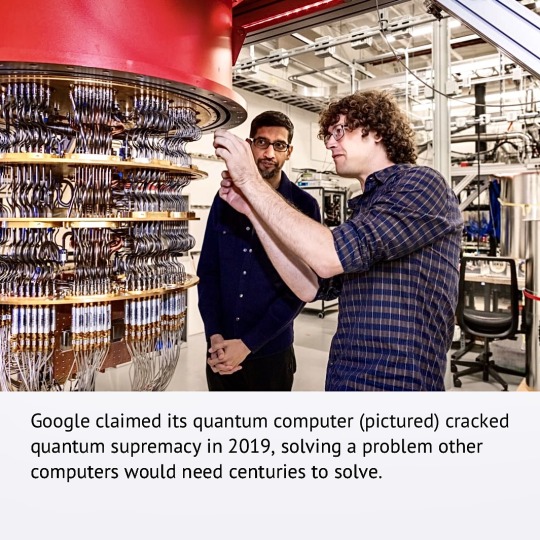

Google’s quantum computer instantly makes calculations that take rivals 47 years.
By James Titcomb
The Age - July 3, 2023
Originally published by The Telegraph, London
#Computers#Supercomputers#Quantum computing#Technology#Research & development#Google#Phase Transition in Random Circuit Sampling#ArXiv#Quantum physics#Science
1 note
·
View note
Text
Quantum Teleportation & Traversable Wormholes - By Geox
A White Paper on the Non‑linear Entanglement Manifold Architecture (NEMA) Author: Geox Version 1.0 — June 17 2025 (supersedes Design v0.4) Abstract Teleporting macroscopic matter up to and including conscious organisms has long been relegated to fiction. We present a dual‑path engineering program that (i) transfers complete quantum‑classical state information for re‑assembly and (ii) exploits…
#fiction#NEMA#Non‑linear Entanglement Manifold Architecture#Non‑linear Entanglement Manifold Architecture (NEMA)#Quantum Teleportation#Quantum Teleportation & Traversable Wormholes#Quantum‐State Transfer & Re‑Assembly#short-story#Teleportation#Traversable Wormhole Transit#wormhole#writing
0 notes
Text
Can We Store Data Without Storage Devices?
Can We Store Data Without Storage Devices? Learn about RAM-only systems, DNA data, quantum memory, and more cutting-edge innovations redefining how we store data. Can We Store Data Without Storage Devices? Introduction In the modern digital world, data is the backbone of almost everything—be it communication, business operations, or scientific advancements. Traditionally, this data is stored…
#brain data storage#can data exist without storage#data storage without devices#data-in-transit#DNA data storage#ephemeral data storage#futuristic data storage#holographic storage#in-memory computing#no storage technology#non-traditional storage#quantum data storage#RAM-only systems#store data without hard drive#volatile memory computing
0 notes
Text
Visualizing dynamics of charges and strings in (2 + 1)D lattice gauge theories
Experimental techniques and device characterization Gate implementation All experiments in this work can be carried out on a grid of 45 qubits with square connectivity and were implemented on a 72-qubit Google Sycamore processor, as used in ref. 49 (Extended Data Fig. 1). Dominant errors come from CZ entangling gates50 and final readout51. Qubit, coupler and readout parameters are optimized using…
#Humanities and Social Sciences#multidisciplinary#Phase transitions and critical phenomena#Quantum simulation#Science
0 notes
Text
Universality

Universality is a profound and foundational concept in science and mathematics that describes the property by which systems with vastly different microscopic details exhibit the same macroscopic behavior. It is most prominently observed in the study of critical phenomena in statistical mechanics, but it also emerges across a wide range of disciplines, including condensed matter physics, dynamical systems, chaos theory, mathematics, computer science, and even certain branches of economics and biology. The notion of universality provides a framework for understanding how complex behavior can emerge from simpler rules and how such behavior can be characterized independently of specific details, relying instead on symmetries, dimensions, and collective properties.
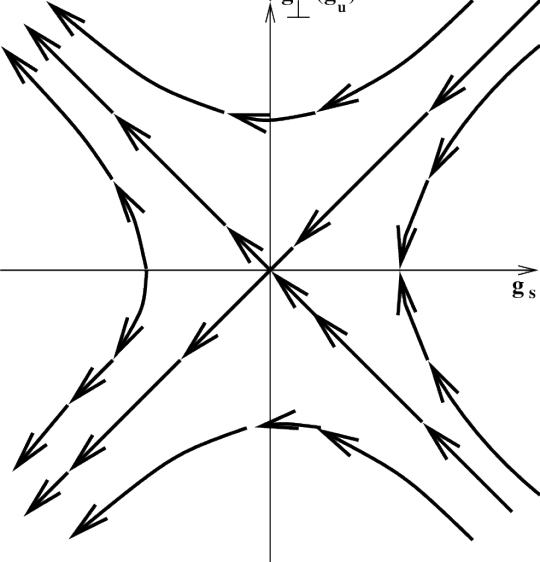
The concept of universality originated in the mid-20th century, particularly in the context of phase transitions in statistical physics. Physicists observed that vastly different physical systems—such as magnets near the Curie point and fluids near the liquid-gas critical point—exhibited strikingly similar behavior near their respective critical points. This was paradoxical because the underlying microscopic interactions in these systems were entirely different.
The resolution of this paradox came with the development of the renormalization group (RG) theory, primarily by Kenneth Wilson in the 1970s. RG provided a rigorous framework to explain how systems at different scales could be related through scale transformations, and how certain large-scale behaviors are invariant under these transformations. Universality emerged naturally from this framework: systems that flow toward the same fixed point in the space of physical theories under RG transformations exhibit the same critical exponents and scaling laws, regardless of their microscopic details. This laid the foundation for a deep understanding of universality and marked a turning point in theoretical physics.
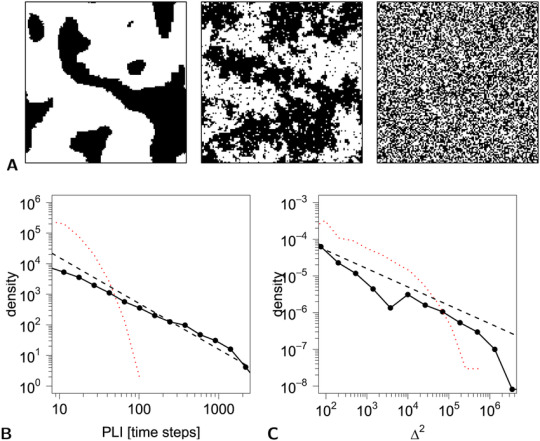
A central feature of universality is the classification of systems into universality classes. These are groups of systems that, despite differences in their microscopic structures or interactions, share the same set of critical exponents, scaling functions, and general behavior near criticality.
The primary determinants of universality classes are:
Dimensionality of the system – The number of spatial dimensions significantly affects the critical behavior of a system. For example, the Ising model in two dimensions has different critical exponents than in three dimensions.
Symmetry of the order parameter – The nature of the symmetry breaking involved in the phase transition plays a key role. The Ising model, with a discrete Z2 symmetry, belongs to a different universality class than models with continuous symmetries like O(N) (e.g., the XY and Heisenberg models).
Range of interactions – Systems with short-range interactions often belong to different universality classes than those with long-range interactions.
Conservation laws and dynamics – In dynamical systems, the conservation or non-conservation of order parameters (such as energy or magnetization) can define dynamic universality classes distinct from their static counterparts.
Examples of well-known universality classes include the Ising universality class (scalar order parameter with Z2 symmetry), the XY universality class (vector order parameter with U(1) symmetry), and the Heisenberg universality class (vector order parameter with SO(3) symmetry).
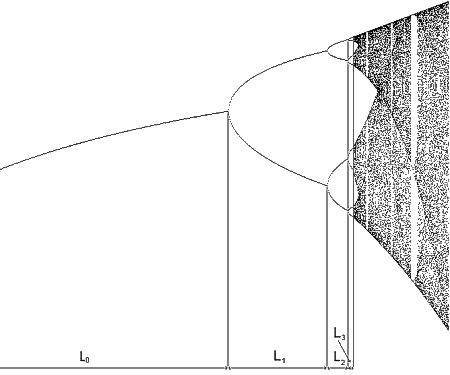
The renormalization group (RG) formalism is essential to the modern understanding of universality. It describes how physical systems behave under changes in scale, allowing for the systematic "coarse-graining" of microscopic details while retaining the large-scale features that determine macroscopic behavior.
The key idea in RG is that as one examines a system at increasingly larger scales, the effective parameters governing the system’s behavior flow under RG transformations. At critical points, these flows approach fixed points, which correspond to scale-invariant behavior. Systems that flow toward the same fixed point share universal properties—hence the emergence of universality.
In this context, critical exponents describe how physical quantities diverge near the critical point (e.g., specific heat, susceptibility, correlation length), and these exponents are determined by the properties of the RG fixed point, not the microscopic details of the system. For instance, the critical exponent β, which describes how the order parameter vanishes near the critical temperature, is the same for all systems in the same universality class.
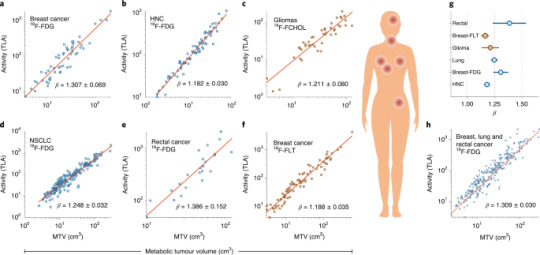
While the concept of universality originated in statistical mechanics, its implications extend far beyond that domain.
1. Dynamical Systems and Chaos
In the study of deterministic chaos, universality appears in the context of bifurcation theory and the transition to chaos. One of the most striking examples is the Feigenbaum constants, which describe the rate of period-doubling bifurcations in one-dimensional maps such as the logistic map. Regardless of the specific form of the map, the ratio of intervals between bifurcations converges to the same universal constant (~4.669), and the scaling behavior near the onset of chaos follows universal laws. This indicates that the transition to chaos in wide classes of dynamical systems exhibits universal features.
2. Quantum Field Theory and High-Energy Physics
Universality is also a key idea in quantum field theory (QFT), where it helps explain why effective field theories at low energies can be described using a limited set of relevant operators, despite the potential complexity of high-energy (UV) theories. RG methods show that low-energy phenomena are governed by universality classes characterized by the relevant operators at an IR (infrared) fixed point.
In lattice gauge theories and studies of quantum critical points, universality informs the scaling behavior of observables near quantum phase transitions, which occur at absolute zero and are driven by quantum fluctuations rather than thermal ones.
3. Computer Science and Algorithmic Universality
In theoretical computer science, a different kind of universality appears in the concept of computational universality, particularly in Turing completeness. A computational system (e.g., a Turing machine or lambda calculus) is said to be universal if it can simulate any other computational system. This form of universality is foundational to the theory of computation and underlies the universality of general-purpose computers.
Cellular automata also exhibit universality. For example, Conway’s Game of Life is computationally universal, meaning that it can simulate a Turing machine despite its simple local rules.
4. Percolation, Fractals, and Geometry
Percolation theory provides another domain where universality emerges. Near the percolation threshold, properties like the size of connected clusters exhibit power-law distributions characterized by universal critical exponents. These exponents depend only on the dimensionality of the system and not on the microscopic details of the lattice or geometry.
Fractals, which exhibit self-similarity and non-integer dimensions, are also associated with universality. The fractal dimensions of certain critical clusters (e.g., in percolation or the Ising model) are universal and can be related to the scaling laws governing the system.
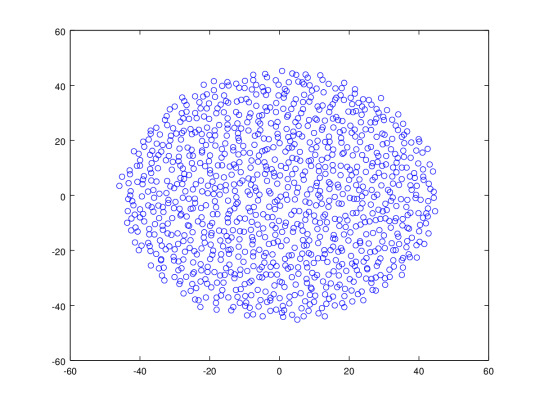
Although more speculative and less rigorously defined, analogs of universality have been proposed in biological and economic systems. For example, scaling laws in biological systems—such as the relation between metabolic rate and body mass (e.g., Kleiber’s law)—exhibit regular patterns across a vast range of organisms. Similarly, certain macroeconomic behaviors, such as power-law distributions in wealth and income or the scaling of urban infrastructure with population size, have been argued to reflect universal principles.
However, unlike in physics, the presence of complex, adaptive agents and feedback loops in these systems complicates the identification of precise universality classes or fixed points. Nonetheless, attempts to apply statistical physics and RG-like methods in these fields continue to be active areas of interdisciplinary research.
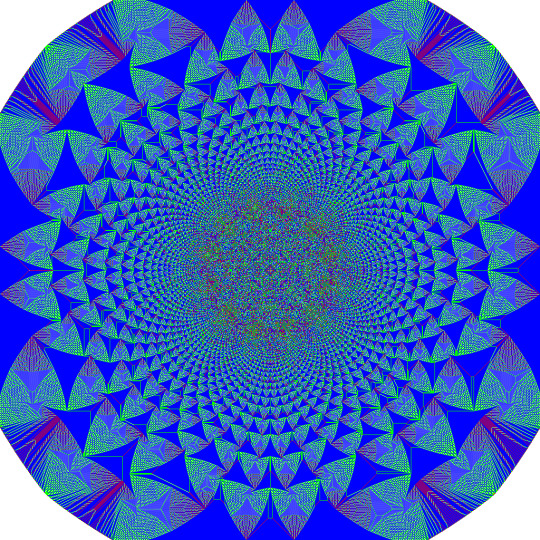
Universality in a formal mathematical sense often involves invariance under group actions, limit theorems, or fixed-point theory. For example:
Central Limit Theorem: One of the simplest manifestations of universality in probability theory. It states that the distribution of the sum of many independent random variables tends toward a Gaussian distribution, regardless of the underlying distribution, provided the variance is finite.
Random Matrix Theory: In the study of eigenvalues of large random matrices, universality appears in the distribution of spacing between eigenvalues, such as the Wigner-Dyson distribution. These distributions are universal across broad classes of ensembles, including those modeling nuclei, disordered systems, and even zeros of the Riemann zeta function.
Scaling Limits and Universality in Stochastic Processes: Brownian motion, the scaling limit of many discrete random walks, provides a classical example. Similarly, the Kardar-Parisi-Zhang (KPZ) universality class encompasses a wide range of stochastic growth models that, despite different dynamics, share the same large-scale statistical properties.

Universality challenges reductionist viewpoints by emphasizing that many macroscopic behaviors are insensitive to microscopic details. This has profound implications for how scientists model and understand complex systems. Rather than focusing on the exact microscopic state of a system, one can study representative models that capture the relevant symmetries and conservation laws to extract universal predictions.
It also exemplifies the power of abstraction and the importance of symmetry and scaling in nature. The idea that fundamentally different systems can exhibit identical critical behavior suggests that there are deep organizing principles underlying complex phenomena.
Furthermore, the concept has epistemological significance, influencing how knowledge is structured and how laws of nature are interpreted. It bridges the gap between the particular and the general, providing a unifying framework for diverse phenomena.
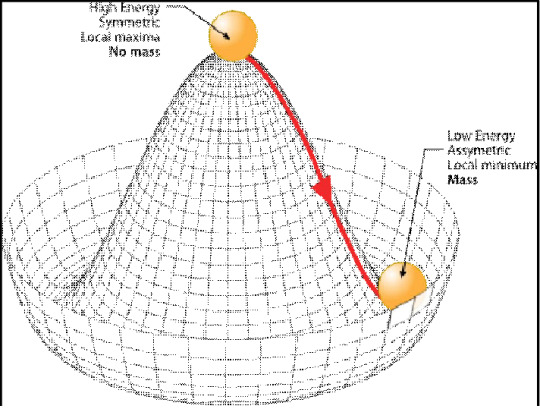
Universality is a cornerstone of modern science, offering a window into the fundamental structure of complex systems. From phase transitions and critical phenomena to dynamical chaos, quantum fields, algorithmic computation, and beyond, universality reveals the deep and often surprising regularities that transcend specific details. Its discovery and formalization represent one of the most profound insights in 20th-century physics, with ongoing implications for a broad range of disciplines in the 21st century. As science progresses, the principle of universality continues to guide our understanding of emergent behavior, scale invariance, and the interconnectedness of nature.
#universality#critical phenomena#scale laws#renormalization group#fractal geometry#chaos theory#complex systems#emergence#systems philosophy#interconnectedness#science thoughts#deep physics#mathematical beauty#physics aesthetic#theoretical physics#quantum field theory#computational theory#algorithmic aesthetic#symmetry breaking#phase transitions#feigenbaum constants#science lovers#philosophy of science#statistical mechanics#patterns in chaos#universal laws#scientific philosophy#epistemology
0 notes
Text
"A team of Rice University researchers reported the first direct observation of a surprising quantum phenomenon predicted over half a century ago, opening pathways for revolutionary applications in quantum computing, communication, and sensing.
Known as a superradiant phase transition (SRPT), the phenomenon occurs when two groups of quantum particles begin to fluctuate in a coordinated, collective way without any external trigger, forming a new state of matter.
The discovery was made in a crystal composed of erbium, iron, and oxygen that was cooled to minus 457 Fahrenheit and exposed to a powerful magnetic field of up to 7 tesla (over 100,000 times stronger than Earth's magnetic field), according to a study published in Science Advances.
"Originally, the SRPT was proposed as arising from interactions between quantum vacuum fluctuations—quantum light fields naturally existing even in completely empty space—and matter fluctuations," said Dasom Kim, a Rice doctoral student in the Applied Physics Graduate Program who is a lead author on the study.
"However, in our work, we realized this transition by coupling two distinct magnetic subsystems—the spin fluctuations of iron ions and of erbium ions within the crystal."
Spin describes the magnetic poles of electrons or other particles and can be envisioned as a tiny arrow attached to each particle, constantly twirling and pointing in a given direction. When spins align, they create magnetic patterns across a material. When the pattern of spins ripples across the material like a wave, the resulting collective excitation is known as a magnon."
continue reading article
#physics#quantum physics#magnetism#energy#wavelength#frequency#transition#magnetic patterns#spinning#oscillation#rotation#scaling#electrons#matter#science#discovery#superradiant phase transition#quantum light
1 note
·
View note
Text
🔵🔮Leaving the Age of Material and Entering the Age of Frequency (Tone: 540)
Posted on November 18th, 2024 by @SergeiDavidoff ABOUT THIS VIDEO: The video features Franco Romero, a psychic medium, discussing humanity’s transition from a materialistic era into the “Age of Frequency.” The central premise is that Earth operates as a “school” and that humanity is at a pivotal point of spiritual activation and internal transformation. This change involves moving from…

View On WordPress
#2025 Awakening#3D to 5D Transition#Age of Frequency#ascension process#Astrology#consciousness shift#Dimensional Split#Divine Child Energy#divine feminine#Divine Masculine#Earth School#Energy Codes#Energy Portals#Franco Romero#galactic federation#Global Chaos#higher consciousness#Human Awakening#Internal Transformation#Metaphysical Teachings#psychic predictions#Quantum Energy#Spiritual Awakening#Spirituality and Science#Three Days of Darkness
0 notes
Text

Controlling quantum particle states through structural phase transition of crystals
A research team has successfully fine-tuned the Rabi oscillation of polaritons, quantum composite particles, by leveraging changes in electrical properties induced by crystal structure transformation. Published in Advanced Science, this study demonstrates that the properties of quantum particles can be controlled without the need for complex external devices, which is expected to greatly enhance the feasibility of practical quantum technology. The team was led by Professor Chang-Hee Cho from the Department of Physics and Chemistry at DGIST. Quantum technology enables much faster and more precise information processing than conventional electronic devices and is gaining attention as a key driver of future industries, including quantum computing, communications, and sensors. At the core of this technology lies the ability to accurately generate and control quantum states. In particular, recent research has been actively exploring light-based quantum devices, with polaritons at the center of this field.
Read more.
#Materials Science#Science#Quantum mechanics#Phase transitions#Phases#Crystals#Quasiparticles#Ferroelectric#Crystal structures#Perovskites
12 notes
·
View notes
Text
"Harmonizing Elements: Navigating the Path to Greater Enlightenment"
Introduction: Journey Through the Spectrum of Resilience Harmonizing Elements: A Dance of Bliss and Energy” – Curated by Shianna S. Interactive Quiz: Navigating the Path to Greater Enlightenment Embark on a journey of self-discovery and explore the harmony between bliss, energy, and your path to greater enlightenment with our interactive quiz. Each question is designed to guide you closer to…

View On WordPress
#achieving balance and harmony#benefits of mindfulness#chakra balancing guide#connecting with nature spiritually#cultivating inner wisdom#embracing change positively#emotional healing methods#energy healing techniques#energy work basics#enhancing life quality through spirituality#finding inner peace#holistic wellness strategies#life purpose exploration#meditation for beginners#mindfulness and productivity.#mindfulness practices#nature&039;s healing power#navigating life transitions#overcoming life&039;s challenges#personal growth journey#positive mindset cultivation#quantum spirituality insights#self-discovery tools#spiritual awakening signs#spiritual enlightenment#spiritual growth stages#stress reduction tips#transformative spiritual practices#understanding elemental energies#yoga for mental health
0 notes
Text
₊⋆ ☾ ⋆⁺₊⋆ Astro Observations Pt 2 ⋆⁺₊⋆ ☾ ⋆⁺₊
8th House & Vulnerability
If you want to look at vulnerability in the birth chart, the 8th house is a great placement to depend on. I find a part of Scorpio Rising's journey is about embracing vulnerability & it's funny because they have Gemini in their 8th house lol. Meaning they are likely to sneak in vulnerable statements into their communication
Jupiter & What We Prioritize
Whatever sign/house Jupiter is located represents the people, things & area of life we prioritize. For example: Jupiter in Cancer located in the 7th house prioritizes their partner & family (if they have a partner & family)
Neptune & Uranus
Neptune can make someone move ethereally, and Uranus can make for someone who moves quick & is clumsy yet influential & eye-catching (those for Neptune/Uranus in the 1st house or Neptune/Uranus aspects to Mars)
3rd & 5th House
Rules over creative projects so transits here can be when we make time to pour into those & our hobbies/motivation to create get activated. 3rd house transits are also beautiful for publishing & online endeavors and 5th house is just pure creative energy which wants to manifest as something fun
9th House Mars
Represents the desire to learn more & more & more. There's not a finite amount of time or hours as to how much this person will dive deep into a subject they like. It's how they become the teachers, guides, gurus & masters because their knowledge becomes their power
The 8th-12th Houses & Infinity
The 8th house rules over the infinite cycle of death & rebirth, the 9th house rules over endless expansion & possibilities, the 10th house rules over linear progress/action, the 11th house rules over quantum evolution and the 12th house rules over ether, the infinity of connectedness
Our IC & The Nervous System
Want to know what you look like when you're at peace? When that nervous system is regulated? When you know you're in an emotionally & psychologically secure environment? Look at your IC sign
5th House Sign: When Does the Inner Child Come Out?
All the great things about the sign of our IC represents ourselves when we feel safe. Once we feel safe, the sign of our 5th house naturally comes out & manifests as our inner child. For example: I have my IC in the sign of Taurus at 0 degrees. I am the EPITOME of chill when I feel like I'm in a safe environment and then the cusp of my 5th house is also in Taurus, then my inner child enjoys earthly experiences. When I feel safe, I don't try to escape my earthly reality & fall back subconsciously on my Pisces South Node (aka early ways my inner child instinctively dealt with life when I felt emotionally unsafe).
#astrology#astrology notes#astro observations#astro tumblr#taurus#scorpio#astro notes#astro community#pisces#cancer
264 notes
·
View notes
Text
Shifting 101: A Complete Beginner’s Guide🐚🫧

This guide will break down everything you need to know about shifting: what it is, how it works, the methods, the science behind it, and practical tips for success.
Scripts to use for beginners: World Building Guide Character Design Guide
What Is Shifting?
Shifting is the process of moving your consciousness to a different reality, whether it’s fictional, parallel, or entirely of your creation. It’s not your imagination—it’s about fully experiencing another reality.
Here's a summary of what it might feel like:
Physical Sensations
Vibrations or Tingling: Many report feeling their body vibrating or tingling, especially during the transition phase.
Weightlessness: A sensation of floating or being disconnected from the physical body.
Pressure Changes: Some describe feeling a "sinking" sensation, or a light pressure on their chest or body.
Warmth or Coolness: A shift in body temperature, often feeling either unusually warm or cool.
Mental and Emotional States
Calmness or Euphoria: A deep sense of peace, happiness, or excitement as they approach the desired reality.
Heightened Awareness: A sharper or more vivid sense of surroundings, even if they are imagined.
Detachment from the Current Reality: A feeling of being "pulled away" from where they currently are, mentally and emotionally.
Clarity: A sudden understanding or awareness of the desired reality, as if it's "right there."
During the Shift
Hypnagogic Imagery: Seeing flashes of light, shapes, or scenes from the desired reality as if in a vivid dream.
Auditory Changes: Hearing voices, sounds, or music associated with the desired reality.
Rapid Heartbeat: Some report their heart racing, which may be a mix of excitement and physiological response.
After the Shift
Being grounded in the Desired Reality: Feeling completely present and immersed in the new environment, often indistinguishable from waking life.
Memories: Retaining memories of the current reality but experiencing them as distant or unimportant compared to the new reality.
Familiarity: Even if the shifted reality is new, it may feel intuitively familiar, like returning to a place you've always known.

Why Do People Shift?
To live out their dream life or be in a fictional world.
Escape stress or explore alternate possibilities.
To experience new perspectives and adventures.
For self growth (mentally, physically, emotionally, spiritually)
How Does Shifting Work?
Shifting focuses on aligning your consciousness with another reality. It may sound mystical, but scientific concepts can explain how it might work:
1. The Role of the Subconscious
Your subconscious mind doesn’t differentiate between imagination and reality—it processes everything you believe as truth. By visualizing and affirming your DR, you’re "rewriting" your mind to accept it as your "true" reality.
2. Brainwaves and Conscious States
Shifting works best when your brain is in certain states:
Alpha: Relaxed but awake, like when you daydream.
Theta: The in-between state of sleep and wakefulness—perfect for accessing your subconscious.
Delta: Deep sleep. Some people shift directly through their dreams.
3. The Quantum Perspective
The Many-Worlds Theory in quantum physics suggests infinite versions of reality exist. Shifting aligns your awareness with a different version of yourself, allowing you to live in that reality.

How to Shift: The Basics
1. Preparation
Create Your DR Script:
Where you’ll be.
Who you’ll meet.
Rules (e.g., “Time stops in my OR while I’m in my DR”).
Safe words (to return to your OR).
Set the Scene: Find a quiet, comfortable place where you won’t be disturbed.
2. Choose a Method
There are many methods to help guide your mind into the void or DR. Here are some popular ones:
The Raven Method: Lie in a starfish position, count to 100, and affirm things like, "I am in my DR." Visualize your DR as vividly as possible.
The Pillow Method: Write your script and place it under your pillow. Visualize your DR as you fall asleep.
The Void Method: Enter a deeply relaxed state, focus on the darkness behind your eyelids, and affirm that you’re in the void (a blank state of pure awareness where you can shift instantly).
3. Let Go and Trust the Process
The most important part of shifting is letting go of resistance. Don’t force the experience—relax and allow it to happen naturally.
Signs You’re Close to Shifting
You might experience these signs as you approach your DR:
Tingling sensations or vibrations.
Feeling weightless or heavy.
Hearing sounds from your DR.
Seeing flashes of light or imagery.
Common Challenges and Solutions
1. I Can’t Relax
Try meditating before starting or doing a body scan (mentally relaxing each part of your body).
2. I Overthink Too Much
Focus on affirmations or play calming music to distract your logical mind.
3. Nothing Happens
This is untrue as this is an assumption. However, it may take a few tries before you get the hang of it

The Science Behind Shifting
While shifting isn’t officially recognized by science, many related phenomena align with psychological and neurological concepts:
Hypnagogia and Hypnopompia: These are the states between wakefulness and sleep, where vivid imagery and sensations occur. They’re key moments for accessing your subconscious.
Lucid Dreaming: Like shifting, lucid dreaming involves awareness and control within a dream. Many people shift through lucid dreaming techniques.
Visualization and Neuroplasticity: Studies show that imagining something activates the same brain areas as doing it. With repetition, you "train" your brain to accept your DR as real.
The Placebo Effect: Your beliefs shape your experience. If you fully believe you’ve shifted, your brain will accept it as true. Can be achieved with the Law of Assumption.
Myths About Shifting
You Can Get Stuck: This is impossible. Your subconscious will always bring you back to your OR when needed.
It’s Dangerous: Shifting is as safe as sleeping or meditating. Unless you decide to shift to a Zombie Apocalypse then duhh.
You Need a Perfect Script/Concept: Having scripts and a good self-concept helps, but they’re not required. Your intention is enough.
Tips for Success
Stay consistent: Shifting gets easier with practice.
Believe in yourself: Doubts can create mental blocks.
Use reminders: Read your script daily to reinforce your DR.
Be patient: Everyone’s journey is different.
P.S. At the end of the day, all you need is yourself. Only you can make you shift. It is not necessary to have a script/method because it's you who's going to make it work. So, do what feels comfortable for you and what works for you. Don't let others tell you otherwise.

#empyrealoasis#shifting community#shiftblr#reality shifting#shifting#shifting consciousness#shifting blog#anti shifters dni#desired reality#4d reality#voidblr#void state#permashifting#respawning#pure consciousness#void
392 notes
·
View notes
Text
Physicists at the University of Bonn and the University of Kaiserslautern-Landau (RPTU) have created a one-dimensional gas out of light. This has enabled them to test theoretical predictions about the transition into this exotic state of matter for the first time. The method used in the experiment by the researchers could be used for examining quantum effects. The results have been published in Nature Physics. Imagine you are standing at a swimming pool and come up with the idea of filling it with even more water. You grab a garden hose and use it to generate a jet of water that curves in a high arc to fall onto the surface of the pool. The water level increases briefly at the point where the jet of water hits the pool, but this change in water level is only minimal because the falling water is quickly distributed across the entire expanse of water.
Continue Reading.
185 notes
·
View notes